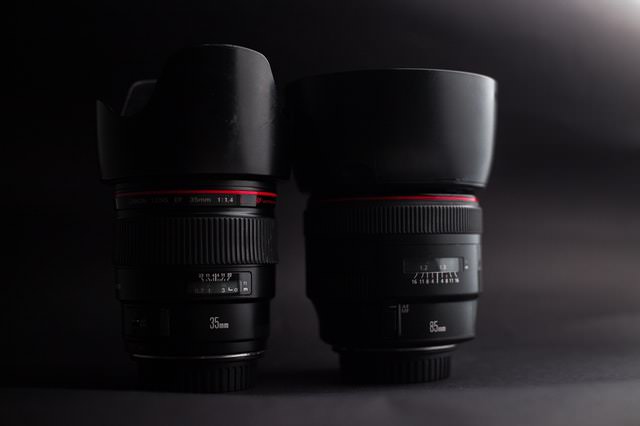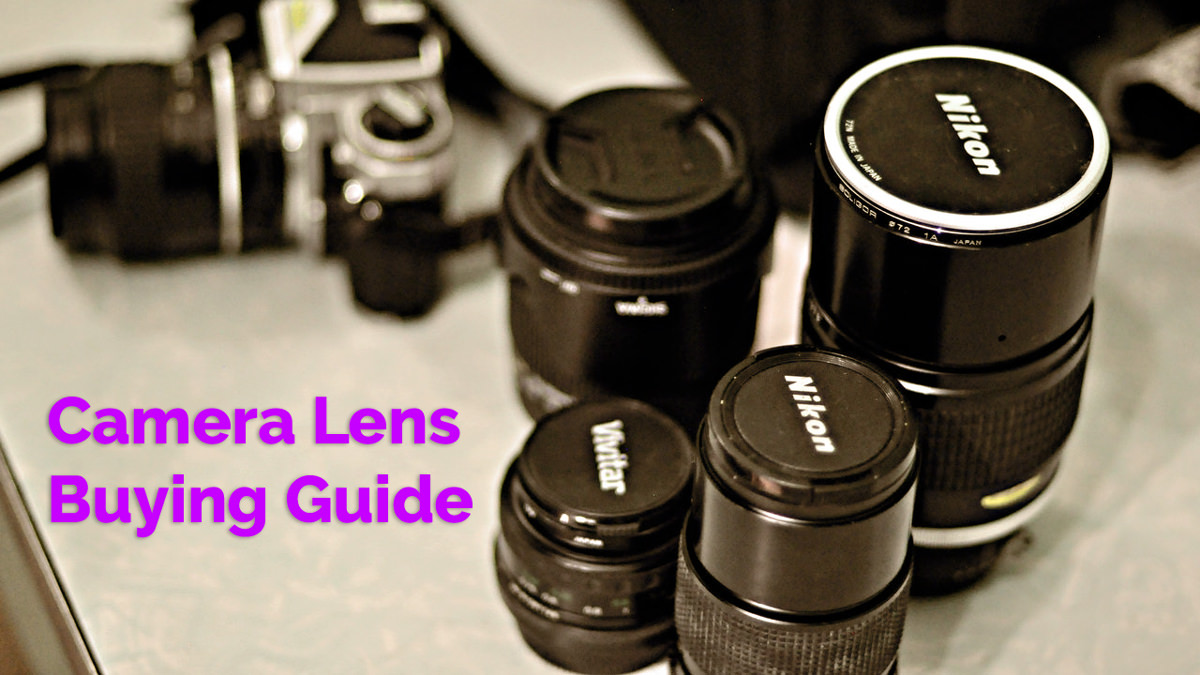Last updated on February 23rd, 2022
Lenses are one of the most expensive equipment in photography — often more than the camera body. This camera lens buying guide for beginners will give you a great idea of what to look for in lenses.
Taking advantage of your digital camera system will inevitably require you to add more lenses to your kit. With more flexibility for framing your composition and zooming in and out, a new lens can provide useful features like image stabilization and weather resistance.
This list will guide you through the various types of lenses available, changing focal lengths, aperture, image quality, and a few other factors that will help you choose your next lens.
If you haven’t bought a camera body already, make sure to read our beginner camera buying guide.
Camera Lens Buying Guide for Beginners

1. Type of Lenses Available
Lenses come in various shapes and sizes, and the first thing you should consider is what kind of lens will suit your needs.
Based on their focal lengths and zoom range, lenses can be wide, standard, telephoto, or prime.
Based on their aperture, they can be slow — which means you will have to slow your shutter speed down to compensate for the small aperture — or fast.
For close-up shots of flowers and insects, you can get dedicated ‘macro’ lenses.
Let’s learn about these categories in brief.
Wide-Angle Lenses
The term ‘angle’ refers to the area of the scene you’ll be able to capture in the image.
With an ultra-wide-angle lens, you can get almost the same field of view as your own eyes, although anything in the center will be magnified and bulge out because of how these lenses are constructed. This is known as barrel distortion.
Ultra wide-angle lenses usually start with a focal length of about 10 mm. All lenses from 8 mm to about 15 mm will give you a distorted perspective with curved edges and are called ‘fisheye’ lenses. You cannot use them for flattering portraits, but they can work well for landscape shots.
Standard Zoom Lenses
The zoom range from 18-60 mm is the normal focal range and is often called ‘standard zoom.’ They are the most versatile because of the human eye-like perspective they create and can be used for wide-angle landscape shots and close-up portraits. Most kit lenses fall into this category.
Since these are cheap, compact, and provide decent image quality, a standard 18-55 mm lens is a good choice for your first buy and is great for beginners.
Telephoto Lenses
Opposite to wide-angle are telephoto lenses. They give you a zoomed-in look and can be useful for getting close-ups.
Telephoto lenses are a good option if you are looking to expand your kit, especially because they work well for wildlife and travel photography.
Unless you buy professional-grade glass, you can get a 70-200mm lens for almost any camera for less than $500.
Prime Lenses
The lens categories above were zoom lenses, which let you zoom in and out by changing the focal length. Prime lenses, on the contrary, have only one focal length that cannot change.
35mm or 50mm prime lenses are an excellent choice for a beginner. They force you to move around and rely on your feet, and their simple design makes them highly portable and cheap. Because their construction is not particularly complex, they come with large apertures like f/2.8.
For portraits, street photography, and general travel photos, a prime lens will work well.
2. Aperture
Along with a focal range that suits your needs, you will also have to pay attention to the aperture of the lens.
Aperture is the opening of the lens, and a larger aperture allows more light to come in.
It also impacts the depth of field, which is that area of the image which will be in focus. A larger aperture will give you lesser depth, creating more background blur and fantastic bokeh.
Because of the manner of construction, the aperture of most lenses reduces as you zoom in. A typical kit lens will have a range of f/3.6 – f/5.6, from 18mm to the 55mm end. This means that as you zoom in, you will have to slow down your shutter speed to compensate for the smaller aperture.
Try to buy a lens with as large an aperture as possible, something around f/2.8. Although more expensive, a lens with a constant aperture like the 24-70mm f/2.8 will be useful for portraits, shooting in low-light and avoiding any handheld blur.
3. Lens Mount
Each camera company has its own mount, which means that you can only use those lenses that match your camera’s mount.
Canon’s lens mounts for its full-frame cameras are named ‘EF.’ EF-S is for its APS-C cameras, while EF-M is for its mirrorless cameras.
Similarly, Nikon’s lens mount is designated as ‘F mount,’ with lenses for full-frame cameras named ‘FX,’ and ‘DX’ for APS-C bodies.
Fujifilm cameras use the XF mount.
Make sure that you are choosing the correct mount before you buy the lens.
4. Lens Compatibility
Along with the correct lens mount, you will also have to check if the lens will match your image sensor size. And if functions like autofocus, metering, and stabilization will work or not.
One thing to keep in mind is that lenses for full-frame cameras have greater coverage. Therefore, they will work on APS-C cameras too, which have a smaller sensor. However, the opposite is not true.
If you use a lens designed for crop sensors on a full-frame camera, you’ll get a dark circle on the edges of the photo since such a lens won’t cover the sensor fully.
Also, you should check the lenses’ specifications to ensure that your camera will support all its functionalities. For example, Nikon’s new 18-55mm kit lens is an AF-P lens, requiring the user to go into the camera menu to turn vibration reduction on or off and enable full manual focus mode. The AF-P lens will work with new Nikon cameras, but bodies like the Nikon D3300 will need a firmware update, while an old model like the D7000 won’t support it.
5. Autofocus
A smooth and quiet focus mechanism is one of the most critical features of any lens. But depending on the lens and its price, the AF system will change too.
If you’re looking at Canon glass, you can consider the USM series of lenses, which stands for ‘Ultrasonic Motor.’ USM lenses are more expensive but faster and quieter while focusing than cheap lenses, and much better for videography.
Nikon’s ultrasonic version is the SWM, which stands for ‘Silent Wave Motor’ and is found in Nikon’s AF-S lenses.
For a cheaper alternative, you can also get lenses with a ‘stepper’ motor like the Nikon AF-P or a lens with micromotors, which 3rd party manufacturers offer like Tamron and Sigma.
If you are enthusiastic about manual focusing and like to rely on your own hands, you should go for a lens that comes with a manual focus override. The advantage of this is that you can always tweak the focus manually, even in auto mode, and there is no need to switch between AF and MF every time.
6. Image stabilization
Photos often turn out blurry in low-light or when zoomed in because of moving hands and camera shake.
Nowadays, many lenses come with internal stabilization rated to about 3 or 4 f-stops, which reduces blur and lets you use slower shutter speeds.
Optical stabilization is always preferable over digital stabilization because it doesn’t affect the image’s quality and resolution.
As usual, different companies name their systems differently. Canon lenses that have stabilization will have ‘IS’ in their name, which denotes image stabilization. Nikon lenses come with ‘VR’ — vibration reduction. If you use telephoto lenses a lot, this feature should be given the highest priority.
7. Build Quality
A lens needs to be sharp and sturdy; otherwise, minor damage will cause unpleasing images.
To ensure that your lens gives you the sharpest possible images and lasts for years, try to buy one that comes with weather resistance, like the amazing Pentax ‘Limited’ WR lenses. It will also be useful in case you take your camera for hikes in a monsoon.
Furthermore, check if the lens mount is plastic or metal; getting a metal mount will give your lens a significantly longer life.
The sharpness of a lens is also affected by the kind of glass that is used — not all glass are equal.
Try to go for lenses that come with a plastic lens hood and use low dispersion glass, reducing chromatic aberration and preventing excessive lens flare and ghosting.
Conclusion
A camera can only perform as well as the lens attached to it. That’s why the rule of thumb is to get the cheapest camera that fulfills your requirements and the most expensive lens you can afford within your budget.
Most photographers recommend allocating one-third of your budget to your camera body and the remaining two-thirds to your lens(es). In contrast, if you’re going pro, you’ll want to get the best camera and lenses combination to make sure your product (photos) doesn’t underperform.
Camera companies like to give their lenses long, complicated names, but a few features are always standard. As a beginner, your primary focus should be buying a lens with the right focal length and a large aperture so that you can get the reach you need without worrying about low light.
Autofocus, image stabilization, and weather resistance are also essential features, and can help you nail the shot without having to always dial in the perfect settings. Further, do not forget to check the lens mount and its compatibility with your camera.
Once you have your perfect lens, your camera body will automatically start performing better.

